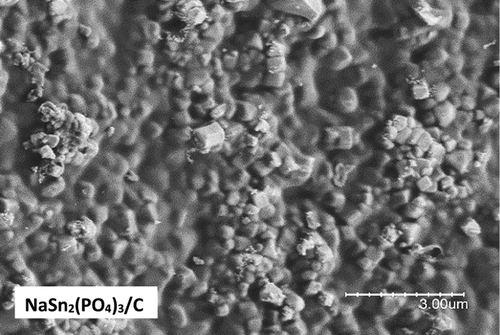当前位置:
X-MOL 学术
›
J. Phys. Chem. C
›
论文详情
Our official English website, www.x-mol.net, welcomes your
feedback! (Note: you will need to create a separate account there.)
Electrochemical Performance and Mechanisms of NaSn2(PO4)3/C Composites as Anode Materials for Li-Ion Batteries
The Journal of Physical Chemistry C ( IF 3.3 ) Pub Date : 2018-04-30 00:00:00 , DOI: 10.1021/acs.jpcc.7b12770 Siham Difi 1, 2 , Abdelhaq Nassiri 2 , Ismael Saadoune 2, 3 , Moulay Tahar Sougrati 1, 4 , Pierre-Emmanuel Lippens 1, 4
The Journal of Physical Chemistry C ( IF 3.3 ) Pub Date : 2018-04-30 00:00:00 , DOI: 10.1021/acs.jpcc.7b12770 Siham Difi 1, 2 , Abdelhaq Nassiri 2 , Ismael Saadoune 2, 3 , Moulay Tahar Sougrati 1, 4 , Pierre-Emmanuel Lippens 1, 4
Affiliation

|
NaSn2(PO4)3/C composites obtained by solid-state and pyrolysis reactions present high capacity retention and high-rate capability as anode materials for Li-ion batteries. The structure of NaSn2(PO4)3 was analyzed by combining X-ray diffraction and density functional theory to confirm the R3̅ space group. The composite is formed by submicrometer particles with a cube-like shape coated by pyrolytic carbon that improves the electronic percolation. The 119Sn Mössbauer spectroscopy shows the existence of Sn4+ with a more ionic character than SnO2, which can be related to the inductive effect of the phosphate groups. This technique was used in the operando mode to follow the reaction with lithium during the first discharge that is a crucial step for improving the performance. A two-step mechanism has been identified that consists of the irreversible transformation of the pristine material into Sn0 species for the first half of the discharge followed by reversible Li–Sn alloying reactions. The Mössbauer spectra of the Sn0 species differ from the spectrum of βSn because of their nanosize and the existence of chemical bonds with the sodium phosphate matrix formed during the conversion reaction. The first part of the discharge should be considered as a restructuration of the pristine material leading to the dispersion of Sn0 small particles in strong interaction with the phosphate matrix and providing good cyclability. Such a mechanism strongly differs from the insertion mechanism of NaTi2(PO4)3/C that contains a transition metal with the same oxidation state as Sn4+.
中文翻译:

NaSn 2(PO 4)3 / C复合材料作为锂离子电池负极材料的电化学性能及机理
通过固态和热解反应获得的NaSn 2(PO 4)3 / C复合材料具有高容量保持率和高倍率性能,可作为锂离子电池的负极材料。NASN的结构2(PO 4)3通过组合X射线衍射和密度泛函理论确认分析- [R 3空间群。该复合物由具有热解碳涂层的立方体形状的亚微米级颗粒形成,该颗粒可改善电子渗透性。在119的Sn穆斯堡尔谱示出了Sn的存在4+与多种离子字符比的SnO 2,这可能与磷酸基团的诱导作用有关。在首次放电过程中,该技术用于操作模式以跟踪与锂的反应,这是提高性能的关键步骤。已经确定了两步机制,包括在放电的前半部分将原始材料不可逆地转化为Sn 0物种,然后进行可逆的Li-Sn合金化反应。Sn 0物种的Mössbauer光谱与βSn的光谱不同,因为它们具有纳米尺寸,并且在转化反应过程中与磷酸钠基质形成化学键。放电的第一部分应被视为原始材料的重组,从而导致Sn的分散0个小颗粒与磷酸盐基质发生强烈相互作用,并提供良好的循环性。这种机理与包含具有与Sn 4+相同氧化态的过渡金属的NaTi 2(PO 4)3 / C的插入机理有很大不同。
更新日期:2018-04-30
中文翻译:

NaSn 2(PO 4)3 / C复合材料作为锂离子电池负极材料的电化学性能及机理
通过固态和热解反应获得的NaSn 2(PO 4)3 / C复合材料具有高容量保持率和高倍率性能,可作为锂离子电池的负极材料。NASN的结构2(PO 4)3通过组合X射线衍射和密度泛函理论确认分析- [R 3空间群。该复合物由具有热解碳涂层的立方体形状的亚微米级颗粒形成,该颗粒可改善电子渗透性。在119的Sn穆斯堡尔谱示出了Sn的存在4+与多种离子字符比的SnO 2,这可能与磷酸基团的诱导作用有关。在首次放电过程中,该技术用于操作模式以跟踪与锂的反应,这是提高性能的关键步骤。已经确定了两步机制,包括在放电的前半部分将原始材料不可逆地转化为Sn 0物种,然后进行可逆的Li-Sn合金化反应。Sn 0物种的Mössbauer光谱与βSn的光谱不同,因为它们具有纳米尺寸,并且在转化反应过程中与磷酸钠基质形成化学键。放电的第一部分应被视为原始材料的重组,从而导致Sn的分散0个小颗粒与磷酸盐基质发生强烈相互作用,并提供良好的循环性。这种机理与包含具有与Sn 4+相同氧化态的过渡金属的NaTi 2(PO 4)3 / C的插入机理有很大不同。











































 京公网安备 11010802027423号
京公网安备 11010802027423号